Why do pumpkin leaves turn yellow, what to do and how to prevent the problem from occurring
What to do if you notice yellowing leaves on your pumpkin? How dangerous is this and what is the reason? How to avoid this? In the article we will tell you why pumpkin leaves turn yellow, how to overcome diseases and pests that cause wilting, what agrotechnical errors can occur, and we will give a number of tips from experienced farmers.
The main reasons for yellowing of pumpkin leaves
To cope with the problem, you need to understand its causes.
Diseases
Pumpkin is resistant to many diseases, but if it becomes infected, it is difficult to treat.. The most common are fungal infections. They are dangerous because of the speed of their spread. Finding the source of the disease can be difficult; infection often begins deep in the soil: the fungus first strikes the root system.
Bacteriosis
First there is a slight yellowing of the leaves, then they quickly turn brown. The reverse side of the leaf becomes stained, and eventually the green mass dries out. This infection also affects the fruits - their development slows down, deformation and drying begin.

Methods of disposal:
- treat with 1% Bordeaux mixture;
- destroy infected parts.
From preventive measures — compliance with the principles of crop rotation.
Powdery mildew
One of the most dangerous diseases for vegetables. Its first sign is a whitish coating. Then the foliage turns yellow, the vines wither and dry up. As a result, the pumpkin weakens and cannot resist other diseases and pests.

Control measures:
- spraying foliage with a solution of colloidal sulfur;
- adding mullein solution to the well;
- treatment with Topaz.
White rot
All begins with a slight, almost imperceptible yellowing of the foliage at the edges, then a white coating appears, which soon becomes slimy. The whole pumpkin rots: the stems, leaves, and fruits suffer.
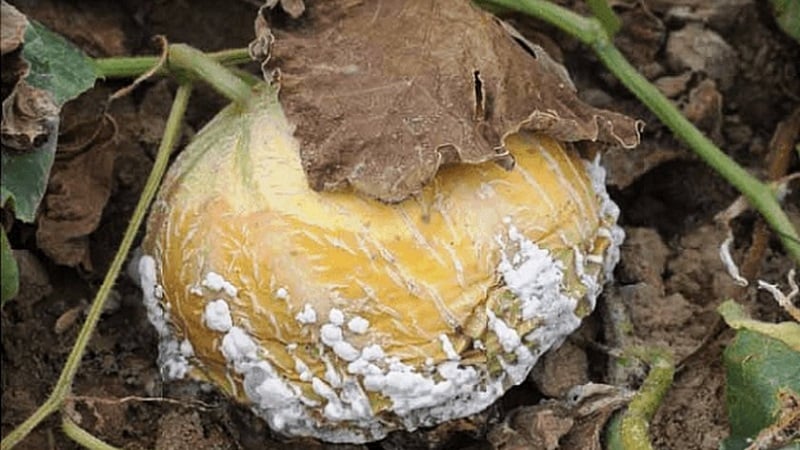
As a countermeasure - treatment with copper sulfate.
Prevention:
- be sure to remove weeds;
- sprinkle the soil with wood ash and chalk.
Root rot
The first stage is rotting of the roots and rapid yellowing of the lower leaves, close to the roots. Then the central stem turns yellow, since the roots are no longer able to provide the plant with the necessary substances for growth.
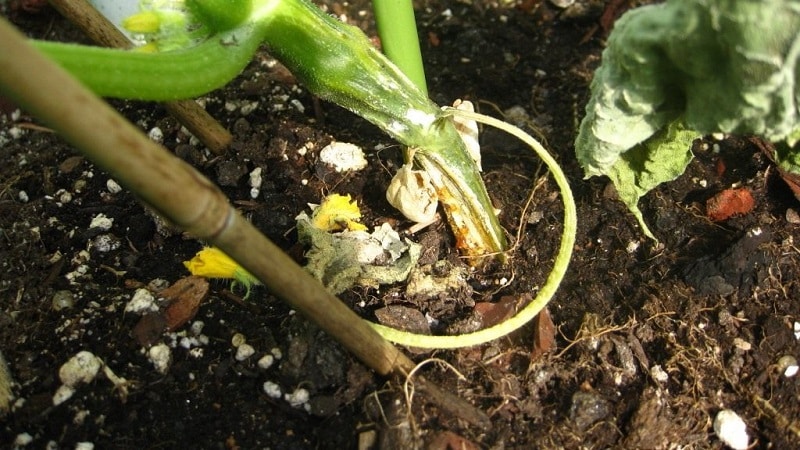
Control measures:
- change the top layer of soil;
- treat the root collar with a 1% solution of Furdanozol.
A good prevention would be treatment above-ground part with wood ash.
Yellow mosaic
Young bushes are her main target. The green mass turns yellow and curls at the edges. The fruits become covered with mosaic spots and become crooked. In this case, even additional fertilizing will not help; the plant simply will not be able to absorb useful elements.
To prevent it, spray with antifungal drugs - Previkur Energy, Bravo or Acrobat.
For prevention:
- Treat seed material and disinfect it.
- Perform spring tillage of soil and plantings to get rid of mosaic vector insects.
- Destroy infected specimens along with the soil.
- Plant the sprouts as far apart as possible.
- Disinfect garden tools (using a solution of vitriol - 4 tablespoons per 1 liter of water or potassium permanganate - 2 tablespoons per 1 liter of water).
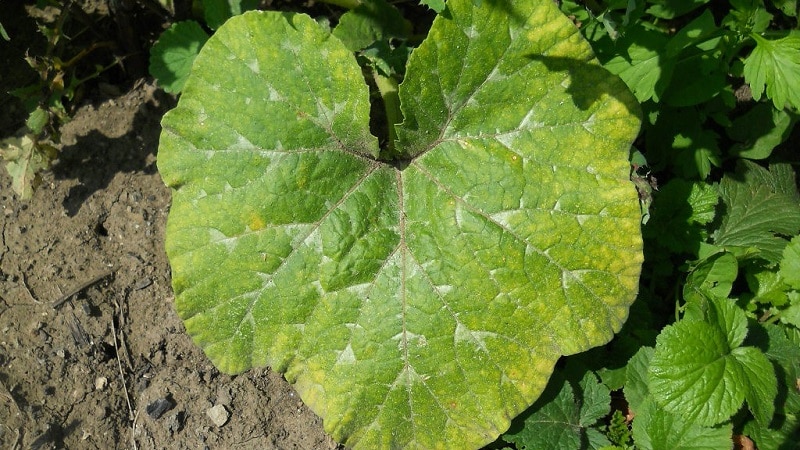
Causes of fungal infections
Here are some of them:
- Wrong watering. Excessive waterlogging of the soil leads to rotting of the roots. Water temperature also has an effect: watering with cold water is not recommended. Long breaks in watering are also dangerous.
- Failure to comply with crop rotation. If you plant the same types of crops in one place for several years, the soil will become depleted and lose its protective and nutritional properties.
- Weeds and insects spread the fungus. Therefore, weeding, removing weeds and loosening the soil are mandatory.
Pests
The leaves of the plant turn yellow if the pumpkin is attacked by insect pests.
Spider mite
A common type of pest. The leaves and stems turn yellow because it entangles them in cobwebs, feeding on the sap of the plant.. This leads not only to drying of the foliage, but also to cracking of the fruit peel.
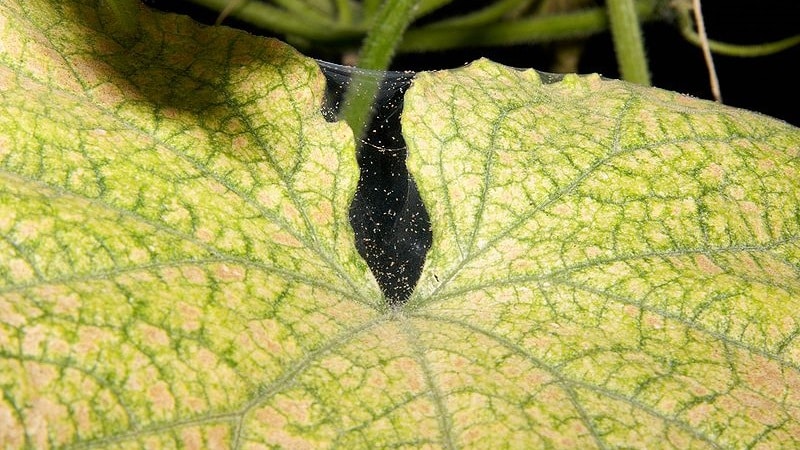
An excellent means of prevention treatment with decoctions of phytoncidal herbs is considered.
If the mite has already settled on the pumpkin, then the biological products “Akarin”, “Bitoxibacillin”, “Fitoverm” are suitable to combat it.
melon aphid
The underside of leaves is a favorite place for this pest.. Aphids spread quickly. Clutches of eggs are located on all parts of the pumpkin. The fight is complicated by the fact that even when it is possible to get rid of the adult individuals, unnoticeable larvae may remain on the plant.

Insecticides will help get rid of pests. Treatment usually takes place in several stages - to destroy both adults and larvae.
For prevention A decoction of phytoncidal herbs is also suitable.
Advice. A folk recipe for fighting melon aphids: 250 g of wood ash is diluted in 10 liters of warm water. Then add 70 g of soap shavings or liquid soap.It is better to spray the beds in the evening. If it suddenly rains after treatment, the procedure is repeated again. Spray the pumpkin until signs of leaf damage are eliminated.
Slugs
They love damp cloudy weather, devour all parts of the plant. You can easily find slugs on a pumpkin, but getting rid of the consequences is a difficult task.
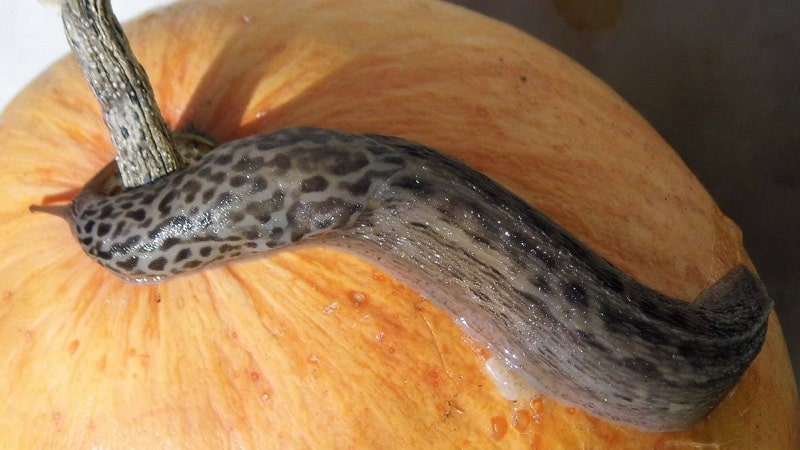
For prevention, loosen the soil around the beds. If the slugs have already appeared, you will have to remove them manually; there is no other way. Then you need to treat the bushes with a solution of tobacco or laundry soap so that they do not return. To prepare a soap solution, wash laundry soap, dissolve it in warm water and spray it on the leaves. The tobacco solution is infused for several days, then sprayed in the same way.
Certain varieties of pumpkin are resistant to diseases and insects - for example, Adagio, Russian And Smile.
Agrotechnical errors
If the pumpkin comes up with yellow leaves or yellowness appeared later, this may mean that agricultural technology has been violated.
Some preventive measures:
- treat seeds before sowing;
- prevent the appearance of weeds in pumpkin crops - this is a breeding ground for diseases and pests;
- disinfect equipment;
- after harvesting, get rid of old plant tops;
- dig up the soil in the fall.
Most pathogens remain on seeds and plant debris. Therefore, pre-sowing disinfection of seeds and soil is mandatory. Plant residues are removed from the garden and burned.
Advice from experienced gardeners
How to grow healthy and tasty pumpkin? Some useful tips from experts:
- A good choice is a lighted, sunny, windless place. Avoid stagnation of soil water.
- Before planting seeds, dig up the soil several times to get rid of insects that destroy the roots.
- The soil is fed with organic and mineral fertilizers. The former include compost, chicken manure, rotted manure, ash, and vermicompost. Minerals are potassium, phosphorus, nitrogen, or complex. But there is also a downside - excess fertilizer in the soil is also detrimental to the ovaries. If the plant has large vines and dense foliage, this indicates an excess of nitrogen. The pumpkin “fattens” - it directs all its energy to the green mass to the detriment of the fruits.
- A high-quality seed should be convex, with a smooth crust, uniform color, and without damage.
- Way seed checks before planting: several seeds are wrapped in a damp cloth and left in a warm place, remembering to periodically wet the cloth. Germination can be assessed after 2-3 days.
- Topping stems is one of the important stages of pumpkin growing. There should be no more than four ovaries per plant. Often in open ground it is formed into two stems - two fruits on the main one, and one on the side.
Conclusion
The main causes of yellowing of pumpkin foliage are fungal diseases, insect damage and agricultural errors. The solution to the problem is simple: take care of the plant, inspect it, treat it at the slightest sign of disease, maintain hygiene of equipment, soil and seed, choose sunny, non-flooded places. Only in this case will you get a healthy harvest.